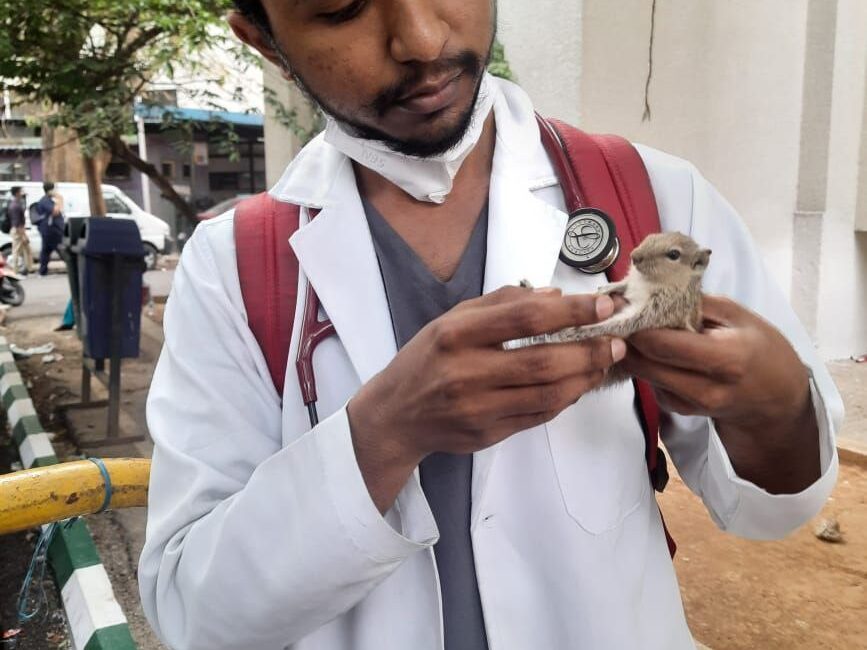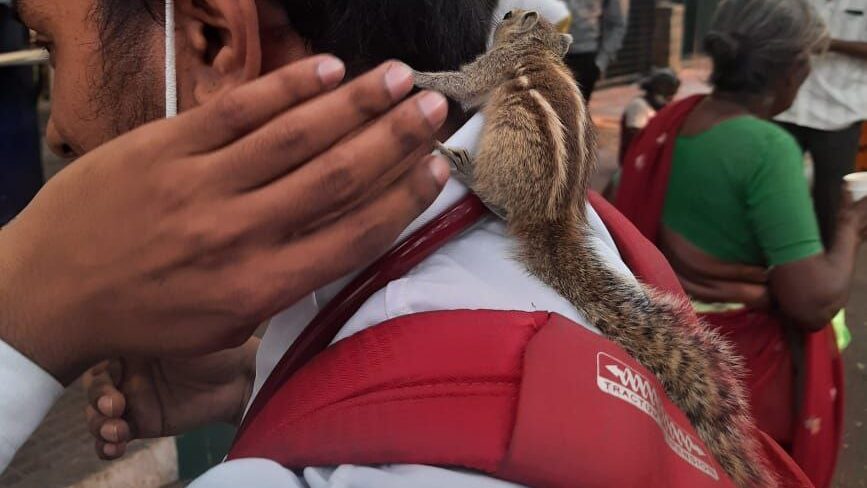
INDIAN PALM SQUIRREL
PHYSICAL CHARACTERS
They have a slender build which allows them to dart through palm trees with ease. This coloration helps them blend in with their surroundings, making them a delightful sight to spot in their natural habitat!
- Their fur is colored brown or grey with white or cream colored underside .
- The measure 25-30cm in length including tail.
- Tail is long furry with a twitch
- They have large and pointed ears
- Eyes appear dark ,bright with white ring around them.
- They have pointed and pinkish snout
- Legs are strong ,agile with sharp claws
- they weigh around 100-150 gms.
MORE ABOUT FUR: Their fur is well-adapted to their environment, helping them blend in with the dappled shade and sunlight filtering through the palm trees. It’s also incredibly soft and cute!
- Soft and silky to the touch
- Brown or greyish-brown on the back and sides
- White or cream-colored on the underside (belly)
- May have a slight orange or reddish tint on the face, legs, and tail
- Thick and dense, helping to protect them from the elements
- Longer on the back, forming a distinctive ridge of fur along the spine
- Shorter on the underside, forming a smooth, creamy-white surface.
TAIL INFO:

- Long and thin, approximately 15-20 cm (6-8 in) in length
- Furry, with a soft and silky texture
- Bushy, with a rounded tip
- Carried with a twitch, often held upright or curved over their back
- Used for balance and agility while jumping and climbing
- Helps them steer while in mid-air, making sharp turns and quick changes in direction
- Communicates emotions and moods, such as twitching or flagging when excited or alarmed
- Has a distinctive white or cream-colored tip, contrasting with the rest of the tail’s brown or greyish-brown color
Their tail is incredibly flexible and expressive, playing a vital role in their locomotion, balance, and communication.
TAXONOMY
- Kingdom: Animalia
- Phylum: Chordata
- Class: Mammalia
- Order: Rodentia
- Family: Sciuridae
- Genus: Funambulus
- Species: F. pennantii
There are five recognized subspecies of Indian palm squirrels:
- F. p. pennantii ( nominate subspecies)
- F. p. argentescens
- F. p. chhattisgarhi
- F. p. gangutrianus
- F. p. kokanensis
Indian palm squirrels are also known by other names, including:
- Five-striped palm squirrel
- Common palm squirrel
- Northern palm squirrel
They are closely related to other palm squirrel species, such as the five-striped palm squirrel (Funambulus sublineatus) and the jungle palm squirrel (Funambulus tristriatus).
HABITAT
Indian Palm Squirrels are found in a variety of habitats, including:
- Tropical forests
- Palm tree plantations
- Urban areas with palm trees
- Gardens and parks
- Coastal regions
- Woodland edges
- Agricultural fields
They are native to the Indian subcontinent and are widely distributed across:
- India (widespread presence)
- Sri Lanka
- Nepal
- Bhutan
- Bangladesh
- Myanmar (formerly Burma)
They thrive in areas with:
- Abundant palm trees (especially coconut, palmyra, and date palms)
- Warm and humid climate
- Access to food sources (fruits, nuts, seeds, and insects)
- Suitable nesting sites (tree cavities, rock crevices, or leaf nests)
These adaptable squirrels can be found in various environments, as long as there are palm trees and a reliable food supply.
EATING HABITS !!!
[Click above to read full post]
To say one word about the squirrel is they are foodies. They love nuts , bread, biscuits, leaves, fruits and many more. Let us know how they search, store food, how they eat and what you can feed.Read more
Indian Palm Squirrels are omnivores, and their diet consists of:
- Fruits: Berries, figs, mangoes, bananas, and other soft fruits.
- Nuts: Palm nuts, almonds, cashews, and other tree nuts.
- Seeds: Sunflower seeds, pumpkin seeds, and other oil-rich seeds.
- Insects: Grasshoppers, crickets, mealworms, and other small insects.
- Small vertebrates: Occasionally, they eat lizards, frogs, or bird eggs.
- Buds and twigs: They nibble on palm buds and twigs, especially during food scarcity.
- Human food: In urban areas, they may eat human-provided food, like peanuts or bread.
- Palm sap: They drink palm sap, especially during times of food scarcity.
- Flowers: They occasionally eat flowers, like coconut or palmyra palm flowers.
Indian Palm Squirrels are adaptable and opportunistic eaters, exploiting various food sources to survive and thrive.
LIFE CYCLE
The life cycle of Indian Palm Squirrels typically consists of:
- Mating: Breeding occurs throughout the year, with peaks during the monsoon season (June-September).
- Gestation: 40-42 days, with females giving birth to 2-4 young (average litter size: 3).
- Birth: Newborn squirrels are blind, hairless, and helpless, weighing around 5-7 grams.
- Infancy (0-6 weeks): Mother cares for the young, nursing and protecting them in the nest.
- Weaning (6-8 weeks): Young squirrels start to venture out, learning to forage and climb.
- Juvenile stage (2-6 months): Squirrels develop skills, explore their surroundings, and become independent.
- Sub-adult stage (6-12 months): Young squirrels reach 75% of adult size, developing adult-like behavior.
- Adulthood (1-2 years): Squirrels attain full size, reach sexual maturity, and start breeding.
- Lifespan: Indian Palm Squirrels typically live 3-5 years in the wild, with some individuals reaching up to 7 years.
Notable aspects of their life cycle include:
- Females can breed again shortly after weaning their previous litter.
- Males do not participate in raising the young.
- Squirrels may experience high mortality rates during their first year, mainly due to predation and accidents.
ECOLOGICAL IMPORTANCE
They play a vital ecological role in their environments, contributing to:
- Seed dispersal: By caching seeds, they help spread plant species, promoting forest regeneration.
- Forest regeneration: They plant seeds in new areas, often in favorable conditions, allowing trees to grow.
- Nutrient cycling: Squirrels bury and forget seeds, acting as nutrient vectors, enriching soil quality.
- Ecosystem engineering: They create pathways and burrows, modifying their environment, and providing habitat for other species.
- Predator control: Squirrels serve as prey for various predators, regulating their populations.
- Forest health indicators: Changes in squirrel populations can signal broader ecosystem issues.
- Ecological connectivity: They facilitate gene flow between tree populations, maintaining genetic diversity.
- Soil turnover: Burrowing activities aerate soil, improving its quality and fertility.
- Supporting biodiversity: Squirrels contribute to complex food webs, interacting with various species.
- Ecosystem resilience: They help maintain ecosystem balance, adapting to environmental changes.
By performing these ecological roles, squirrels, like Indian Palm Squirrels, are essential components of their ecosystems, maintaining the delicate balance of nature.
